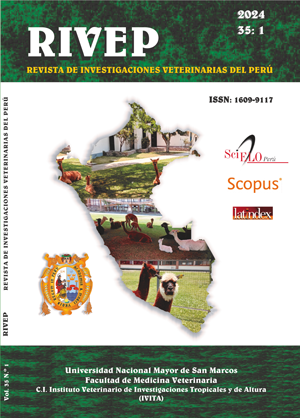Comparison of mathematical models to describe the lactation curve in mares
DOI:
https://doi.org/10.15381/rivep.v35i1.25463Keywords:
equine, lactation, mare's milk, mathematical models, nonlinear regressionAbstract
Six non-linear mathematical models were evaluated (Wood, modified Wood, Quadratic, Sikka, Singh-Gopal and Cobby) to determine their ability to fit to describe the lactation curve in mares. The modeling was carried out from 197 records of milk production from mares between 2 and 190 days of lactation. The models were fitted using non-linear regression algorithms and were evaluated through the following comparison criteria: MAE (Mean Absolute Error), MAPE (Mean Absolute Percentage Error), RMSE (Root Mean Squared Error), AIC (Akaike information criterion), BIC (Bayesian information criterion) and residual analysis. The Wood, Singh-Gopal, modified Wood and Sikka models predicted that maximum milk production varies between 10 and 13 kg/day, which occurs between 30 and 42 days postpartum. According to the criteria evaluated, the Wood and Singh-Gopal models presented the best fit and were suitable for modeling lactation curves in equids.
Downloads
Downloads
Published
Issue
Section
License
Copyright (c) 2024 Ricardo Rosero-Noguera, Sandra L. Posada-Ochoa, Jose R. Martinez-Aranzales

This work is licensed under a Creative Commons Attribution 4.0 International License.
AUTHORS RETAIN THEIR RIGHTS:
a. Authors retain their trade mark rights and patent, and also on any process or procedure described in the article.
b. Authors retain their right to share, copy, distribute, perform and publicly communicate their article (eg, to place their article in an institutional repository or publish it in a book), with an acknowledgment of its initial publication in the Revista de Investigaciones Veterinarias del Perú (RIVEP).
c. Authors retain theirs right to make a subsequent publication of their work, to use the article or any part thereof (eg a compilation of his papers, lecture notes, thesis, or a book), always indicating the source of publication (the originator of the work, journal, volume, number and date).










